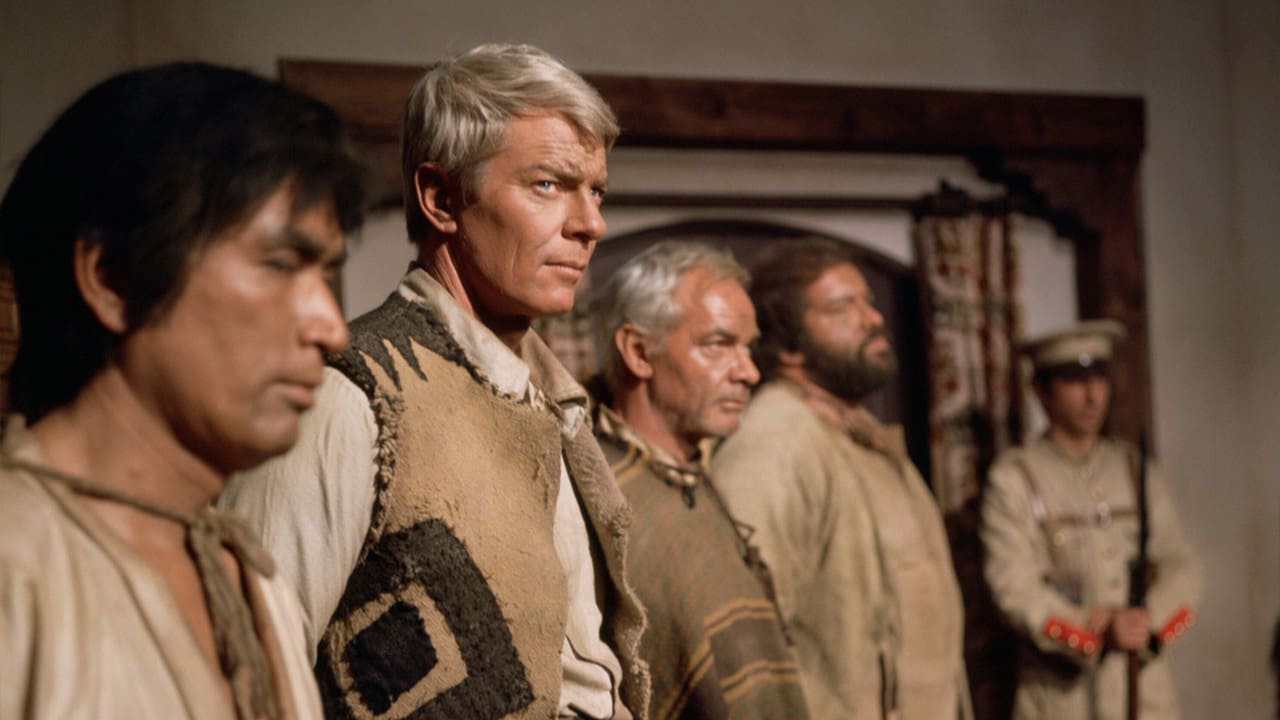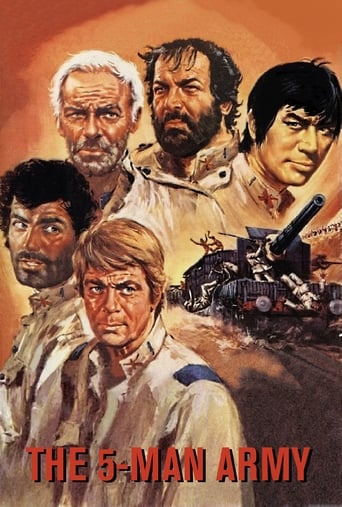

An exiled American soldier known as the Dutchman gathers together a bunch of fellows to embark on a train robbery, telling them that although the locals think they're stealing the gold dust for the Mexican revolution, the gold is really for themselves.Our Five Man Army is made up of the Dutchman, the Captain (an explosives expert), Bud Spencer (a food expert I guess), the Samurai, and a young guy whose name escapes me. It's a heist movie, basically, with loads of Spaghetti Western action thrown in. And an Ennio Morricone soundtrack for good measure.As with the majority of these films, there's plenty of gunfights to keep you going as our army square up to Mexican soldiers, get involved in riots, have punch ups and generally cause mayhem until we get to the heist, which is rather cleverly done and not without tensions.While not an outstanding film, this is a good time waster with plenty of likable characters and a few twists thrown in for good measure.
... View MoreThe Mexican emissary and former acrobat Luis Dominguez (Nino Castelnuovo) comes to America to summon the outlaw Mesito (Bud Spencer) that is working in a farm; the gambler and expert in dynamite Capt. Nicolas Augustus (James Daly); and the mute Japanese Samurai (Tetsuro Tamba) that has a great skill with knives under the call of their acquaintance Dutchman (Peter Graves) from Mexico with the promise of a reward of one thousand dollar for each one. When the five men reunite, Dutchman explains that there is a big, fat, juice train transporting five hundred thousand dollar for the Dictator General Huerta and the leader of the revolutionary forces proposed them to rob the train to support the peasants and the revolution. However, the plan seems to be impossible to be accomplished since the train is protected by an army, but the five men decide to rob the gold and double-cross the revolutionaries. But some of them have hidden intentions "Un Esercito di Cinque Uomini" is a "spaguetti" western at best. The story, with screenplay of Dario Argento, is full of action and betrayals developed in a fast pace and with a great camera work. The result is a funny and entertaining movie, with situations resolved in the most impossible way. My vote is seven.Title (Brazil): "Exército de 5 Homens" ("Five Man Army")
... View MoreOne of the many spaghetti westerns apparently filmed in English, "Un esercito di cinque uomini" (called "The Five Man Army" in English) is nothing really special but worth seeing. Peter Graves plays Dutchman, an American outlaw leading four other men to capture some gold to donate to the Mexican Revolution. This movie really has the feeling of a spaghetti western, what with Ennio Morricone's music and all. The scenery - rolling desert hills - is almost a character itself. Some people may wonder how many movies there can be about people battling corrupt generals, but that misses the point. The point here is to get enthralled, and I'm sure that you will. Overall, the whole movie gives one a really energetic feeling. Pretty interesting, and a neat start for Dario Argento.Watching Peter Graves, I half expected him to blurt out one of his lines from "Airplane!". Maybe that's just me, but he gives me that feeling.
... View MoreThe Five Man Army are "The Dutchman" (Peter Graves) and four colleagues from previous escapades - Mesito (Bud Spencer), a big brute of a man that can knock out an opponent with a big thump to the top of the head (so, the usual Bud Spencer character then!); Samurai (Tetsuro Tamba), a ruthless sword bearing oriental; Captain Augustus (James Daly), an expert with dynamite; and Luis Dominguez (Nino Castelnuovo) an acrobat turned outlaw and the "baby" of the group.The Dutchman has gathered the clan with the promise of a $1,000 reward if they can successfully carry out a robbery of a train (bearing gold to the value of £1 million) on behalf of the Mexican Revolution. The catch is that the train is heavily guarded by soldiers, with the military posted at regular intervals along the journey to resist any attempted theft.This film is an Italian/American co-production, and it does bear traits of both nations particular western styles. It is at times highly entertaining, mostly pretty dumb but always very watchable. The highlight of the movie is the contrasting characters, who are all very likable (albeit fairly clichéd). James Daly in particular has a good role as the ageing Captain Augustus, constantly doubting his (and his colleagues) ability to carry out the heist.The actual robbery itself takes up nigh on half an hour of this movie, with very little dialogue. The scene is well filmed though and does not drag too badly at all. It also features a great scene where the bodies of the armed soldiers are waved about frantically as a signal to the nearby patrolling military that all is well.Ennio Morricone's score is rousing (of course), but does sound like a muddled jigsaw of many of his other works. It fits perfectly, however.It may sound like I am being critical of this film, and I guess that there are a few shortcomings with it. But if you ignore its occasional predictability and just take it for what it is - a highly entertaining yet simple western - you are pretty much guaranteed to enjoy it from beginning to end. I know I did.
... View More